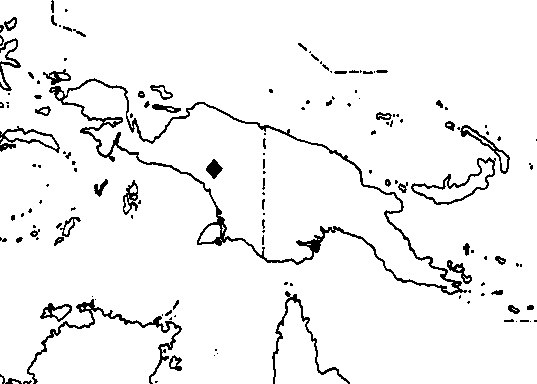
Distribution Map

Description (Barlow 1992)
Species nova A. scandenti (Tieghem) Danser affinis, sed caulibus articulatis, foliis decussatis oblanceolatis vel anguste spathulatis, corolla 4-mera differt - Typus: Brass 11299 (holo L; iso CANB), New Guinea, 18 km NE Lake Habbema. 2200 m, xi.1938.
Glabrous. Stems slender, enlarged and distinctly articulated at the nodes; internodes with fully developed leaves 2-4 cm long. Leaves opposite; lamina oblanceolate to narrowly spathulate, 5-7 cm long, 1-2 cm wide, relatively thick, drying darkcoloured on both sides, gradually attenuate at the base into an obscurely defined petiole 5-10 mm long, rounded at the apex; venation pennate, raised below but indistinct. Inflorescences several at the nodes and developing successively; peduncle 13-15 mm long; rays 4, 5-8 mm long; flowers all sessile in the triads; bracts triangular, 1-1.5 mm long, broadly acute, forming a small spreading involucre below the triads. Ovary slender, 3 mm long, constricted below the limb; limb truncate, 1 mm long, slightly spreading. Corolla in the mature bud slender, 26-30 mm long, red below and yellow towards the apex, quadrangular when dry, acute; petals 4, free, lacking a spur on the inside just above the base. Anther slender, with a short knob-like sterile tip, c. 2.5 mm long, half as long as the free part of the filament. Stigma hardly wider than the style. Fruit not seen.
Amyema arthrocaulis is
known only from the type collection from the highlands of Irian
Jaya (fig. 1). Habitat details and hosts are unknown. The specimen
was referrred to A. scandens by Barlow (1974) and cited
as a selected example of an 'intermediate' specimen which could
not be placed in any of the three subspecies then recognized.
Re-examination in the present study suggests that it represents
an entity, like A. cercidioides and A. canaliculata,
which has acquired a level of morphological and genetic differentiation
and isolation consistent with specific status. Differences previously
overlooked or not given sufficient weight include the opposite
leaves, articulate stems, 4-merous flowers, and relatively short
free part of the staminal filament. See notes under A. scandens
and the species mentioned above.
The articulate stems and 4-merous flowers which distinguish this
species within the A. scandens species complex are also
found in other unrelated species of the New Guinean highlands.
These character states may therefore be the result of parallel
changes in response to the same selection pressures. Amyema
arthrocaulis is probably a young endemic, derived in situ
in the New Guinean highlands from the core stock of the A.
scandens complex.
The specific epithet is derived from the Greek
arthro- ('jointed') and caulos ('stem'), and alludes
to the distinctive stems articulated at the nodes and with relatively
short internodes.
Photographs
Amyema arthrocaulis
updated 17 January 2007